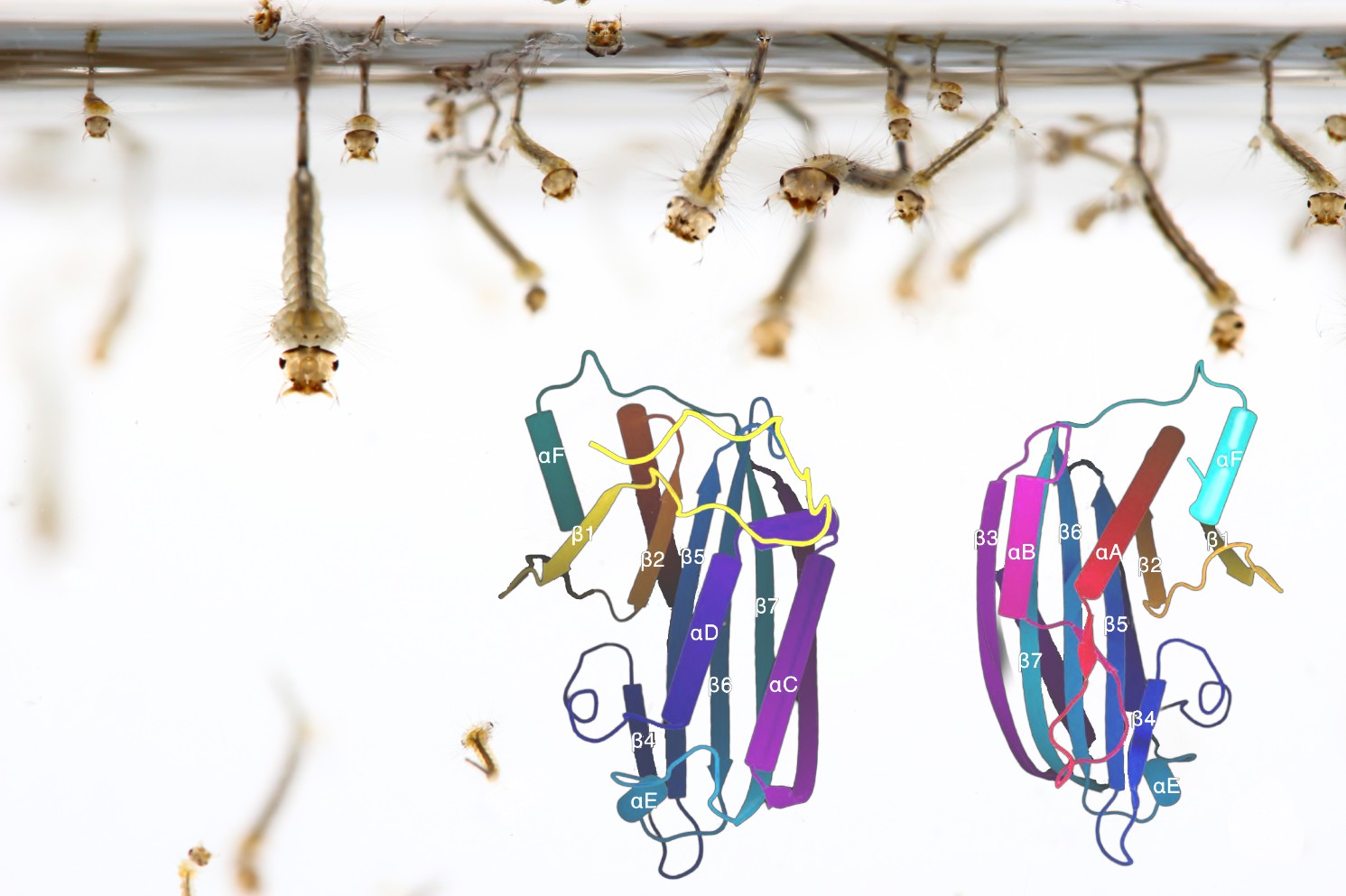X-ray Imaging Reveals Insights into a Natural Mosquito-Killing Compound
Study of a mosquito-targeting toxin produced by bacteria could lead to safer and more effective anti-mosquito products
-By Aliyah Kovner
Many of the chemicals used to deter or eliminate disease-carrying mosquitoes can pollute ecosystems and drive the evolution of even more problematic, insecticide-resistant species – but thankfully, we may have better options soon.
Scientists previously discovered that a strain of naturally occurring bacteria called Bacillus thuringiensis israelensis (Bti) produces several compounds that kill mosquito larvae, yet are harmless to most other organisms. These compounds exist in crystal form inside the bacteria, and when the microbes are eaten by a larva, the high pH and digestive enzymes in their gut cause the crystals to dissolve and rearrange into molecules that perforate the larva’s gut cell membranes, quickly killing the insect.
Now, new research led by Grenoble Alpes University and published in Nature Communications has revealed the atomic structure of the most potent Bti crystal and helped explain the mechanism by which the transformed toxin slices through mosquito cell membranes.
“These results help to explain differences in toxicity even by changing a single atom. This opens the door to the rational design of toxins that are safe and effective, for controlling specific mosquito species or disease targets,” said Nicholas Sauter, a senior scientist in Berkeley Lab’s Molecular Biophysics and Integrated Bioimaging (MBIB) Division and one of the paper’s authors.
Sauter and two other MBIB co-authors used their computing expertise to process the structural data collected by the method of X-ray crystallography, which was performed at SLAC National Accelerator Laboratory’s Linear Coherent Light Source (LCLS). “X-ray laser light sources like the LCLS are the only technology capable of generating beams focused enough to probe the tiny Bti crystals,” added Sauter. “Gathering and then interpreting this complex data involved researchers from 10 institutions – it is a great example of a ‘big science’ collaboration.”
One Step Closer to a Fast-Charging Battery
In collaboration with Brookhaven National Lab, Berkeley Lab researchers were able to visualize a key feature of lithium titanate
-By Julie Chao
Berkeley Lab researchers, working with a team at Brookhaven National Laboratory, have made a key discovery about the dynamic structural changes in a material called lithium titanate, putting scientists one step closer to achieving a fast-charging lithium battery.
The scientists used both experimental and computational techniques to examine lithium titanate, or LTO, while it was undergoing fast charge and were able to see why lithium ions are able to move so fast. Their findings were published recently in the journal Science.
“We were able to visualize a key feature of the structure of LTO,” said Tina Chen, a UC Berkeley graduate student and Berkeley Lab researcher who worked with Berkeley Lab scientist Gerbrand Ceder on the study. “We believe that if we can find materials that can accommodate this feature when they’re cycling, then they may also be good candidates to have high rate capability. LTO would serve as the anode in a battery, but we also want to find better materials for the cathode, and potentially we could apply this to solid electrolytes with higher lithium mobility.”
Lithium-ion batteries, such as those used in cell phones and electric vehicles, can take hours to charge. “There are a lot of materials that if you try to charge your battery too quickly then the capacity will drastically decrease,” Chen said. “The goal is to be able to charge your battery very quickly and still maintain a high capacity.”
Click here for a news release from Brookhaven National Laboratory on this study.
New Library of Artificial Antibodies Could Target Pathogens With Molecular Precision
Berkeley Lab technique could accelerate the design of affordable antibodies for biomedical applications
-By Theresa Duque
A research team led by Berkeley Lab has developed a technique that could accelerate the design of artificial antibodies for biomedical applications – from sensing technologies that detect and neutralize infectious viruses and bacteria, to the early detection of Alzheimer’s.
Unfortunately, antibodies are expensive to manufacture and challenging to store. Now, as reported in the journal ACS Nano, scientists at Berkeley Lab have designed artificial antibodies that rival the chemical diversity of their natural counterparts, but without their fragility, nor the expense.
Ron Zuckermann of Berkeley Lab’s Molecular Foundry and his co-authors engineered a family of protein-like molecules called peptoids to fold into a nanosheet coated with peptoid loops – what the researchers call “loopoids.” While the peptoids direct the formation of the nanosheet, the loopoids create libraries of chemically diverse 2D surfaces that can be tested for biological activity, Zuckermann explained.
The density of loops on the nanosheet offers multiple sites that can simultaneously attach to pathogens, boosting their binding strength. Because of their high surface area, a single nanosheet can bind thousands upon thousands of target proteins, and can even grab onto much larger biological targets like bacterial cells.
While testing the technique, the researchers identified a peptoid nanosheet that selectively binds to a key protein involved in the interaction between the anthrax pathogen and its host cell.
“We can now readily build populations of rugged synthetic materials that can be engineered to recognize a potential pathogen,” said Zuckermann. “It is a shining example of biomimetic nanoscience.”
Researchers from UC San Francisco, New York University, and Pacific Northwest National Laboratory also participated in the work.
Read more at the Molecular Foundry website.
Original post https://alertarticles.info
